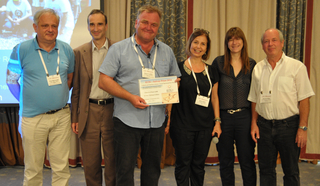
Chemistry and ion speciation of calcium in aqueous solutions was supposed to be known, and tabulated in the chemistry books. The recent studies by Helmut Cölfen and co-workers from the University of Konstanz, Germany, showed that the accepted picture was incomplete. By using a meso-scale thermodynamic approach and different analytical methods, they demonstrated the existence of a domain where the most stable species containing calcium ions was a dynamic oligomer, somewhat like a chimera in between dynamic micelles and polyelectrolytes, really a new type of colloid in a free energy minimum that contains more than 10 and less than hundred ions. This discovery put the inorganic colloid chemistry upside down, and Helmut Cölfen’s pioneering papers, most of them with his colleague Denis Gebauer, are since then used in hundreds of subsequent works, all around the world. This breakthrough unlocked a large number of so far unsolved problems in colloidal and interfacial chemistry. The practical useful realisations stemming from the discovery of generality of these aggregates are:
The existence of stable pre-nucleation clusters triggered the revisiting of the classical nucleation theory that starts from a Smoluchowski approach of a cluster made from aggregating ion pairs. (Nano Today2011, 6, 564; Chem. Soc. Rev.2014, 43, 2348). The existence of colloidal calcium carbonate aggregates, mixed aggregates with magnesium and the effects of amino-acid additives were investigated (Z. Kristallographie2012, 227, 718 and 744).A radically new approach on biomineralization, taking into account the calcium based solvent-swollen colloids (Faraday Discussions2012, 159, 291).Development of a methodology for concentrating the colloidal calcium clusters as a new route towards preparation and analysis of materials based on pre-nucleation clusters (Advanced Functional Materials2012, 22, 4668).Discovery of new synthesis routes towards amorphous calcium carbonate nanoparticles, in controlled size and concentration (Chem. Comm.2013, 49, 9564).
All these papers are stimulating rapid progresses in leading groups all over the world in the field of colloidal chemistry involving inorganic multivalent cations, including micelles and polyelectrolyte gels.
